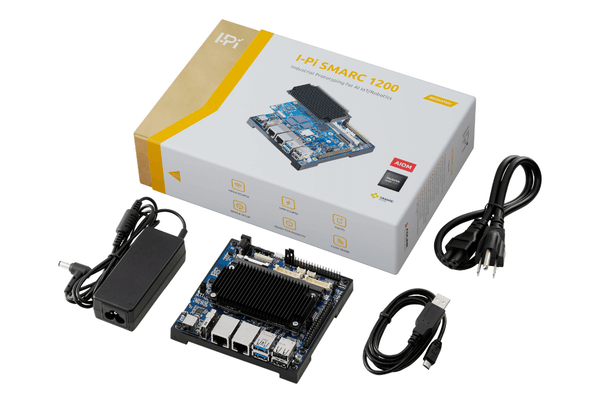The Ultimate Showdown: ADLINK I-Pi SMARC 1200 vs Raspberry Pi 5 for Edge Computing Applications
Many engineering teams are now starting design projects with development kits that package core system components, baseline firmware infrastructure, and supporting documentation to accelerate the prototyping process. Cost and time-to-market are the name of the game in the electronics industry. In fact, many professional engineers state that “aggressive timelines” or “staying within budget” are the most challenging aspects of their job. Today we would like to take a closer look at two different platforms released in 2023: ADLINK’s I-Pi SMARC 1200 development kit based on MediaTek Genio 1200 platform and Raspberry Pi 5 SBC based on Broadcom BCM2712 application processor.

I-Pi SMARC 1200
Specs
I-Pi SMARC 1200 is based on MediaTek Genio 1200 octa-core (4x Arm Cortex-A78 @ 2.2GHz + 4x Arm Cortex-A55 @ 2.0GHz) processor, and supports up to 8GB LPDDR4X memory and up to 256GB UFS storage. Raspberry Pi 5 features the Broadcom BCM2712 quad-core Arm Cortex-A76 processor @ 2.4GHz, and supports up to 8GB LPDDR4X memory and comes without onboard storage option.
| Platform | I-Pi SMARC 1200 | Raspberry Pi 5 |
| SoC |
MediaTek Genio 1200 4x Arm Cortex-A78 and 4x Arm Cortex-A55 |
Broadcom BCM2712 4x Arm Cortex-A76 |
| GPU |
5x Arm Mali-G57 |
VideoCore VII |
| Memory |
Up to 8GB LPDDR4X |
Up to 8GB LPDDR4X |
| Storage |
Up to 256GB USF |
N/A |
| Network |
2x 10/100/1000 Ethernet |
1x 10/100/1000 Ethernet |
| Wireless |
W-Fi 802.11ac/a/b/g/n Bluetooth 5.0/BLE |
Wi-Fi 802.11ac Wi-Fi Bluetooth 5.0/BLE |
| Video |
1x HDMI, 1x eDP or 1x MIPI-DSI |
2x micro HDMI or 2x MIPI-DSI |
| Camera |
3x MIPI-CSI |
2x MIPI-CSI |
| Audio |
1x 3.5mm audio jack |
N.A |
| Extension Busses |
2x USB3.0, 4x USB2.0, UART, 1x CAN, 2x SPI, I2S, I2C, 14x GPIO, 1x PCIe x2 Gen3 |
2x USB3.0, 2x USB2.0, 1x PCIe x1 Gen2 |
| Power |
19V |
5V |
| Operating Temperature |
Standard: 0 C to +60 C Rugged: -20 C to +85 C |
Standard: 0 C to +60 C |
| Dimensions |
110mm x 110mm |
85mm x 56mm |
| OS Supoort |
Yocto, Android |
Raspberry Pi OS |

Raspberry Pi 5 - Photo by Simon Waldherr, CC BY-SA 4.0
How do they compare?
Both the ADLINK I-Pi SMARC 1200 and the Raspberry Pi 5 are powerful and versatile platforms that can be used for various industrial applications, such as industrial IoT, smart homes, smart cities, robotics, edge AI, and more. However, they also have some notable differences that might affect your choice depending on your needs and preferences. Here are some of the main aspects to consider.
Performance
Both platforms offer high-performance processors, and GPUs, but the MediaTek Genio 1200 has an edge over the Raspberry Pi 5 in terms of CPU cores, and AI performance. The MediaTek Genio 1200 also has a dedicated VPU and ISP, which can handle video processing and image recognition tasks more efficiently, making it ideal for edge deployments.
Connectivity
Both platforms support dual display video output and input (I-Pi SMARC 1200 one 4K, Raspberry Pi 5 dual 4K), dual-band Wi-Fi, Bluetooth 5.0, Gigabit Ethernet, and USB 3.0. However, the ADLINK I-Pi SMARC 1200 has more interfaces and connectors, such as DSI, CSI (3 vs. 2), CAN bus, and PCIe Gen3, which might be useful for connecting more sensors, cameras, or peripherals. The Raspberry Pi 5 features a PCIe Gen2 interface, which is slower than the Gen3, and requires a separate M.2 HAT to connect an SSD. The Raspberry Pi 5 also supports PoE+, which can provide power and data over a single cable, but requires a separate PoE+ HAT as well.
Compatibility
I-Pi SMARC 1200 is based on the open, modular SMARC standard, which ensures interoperability and easy integration with different platforms and devices. On the other hand, Raspberry Pi 5 is based on the SBC (single board computer) design, which will make it harder to customize. Both solutions offer compatibility with the Raspberry Pi ecosystem, which includes a large number of accessories, HATs, and software.
Design scalability and flexibility
One of the critical challenges of an embedded system developer is to keep pace with the rapid technological upgrades. SBCs, like Raspberry Pi 5, come with fixed computing, memory, and I/O sections, all of which are integrated on a single PBC, so it not possible to customize the board as per the needs of the application. However, I-Pi SMARC 1200’s modular design offers great flexibility when it comes to choosing between different SKUs and moving between different processor generations and architectures (from x86 to arm and vice versa). The carrier board can be fully customized based on the application characteristic. On top of this, the nature of SMARC open standard allows for a better supply chain management (dual source option), a feature that definitely draws attention of any seasoned project manager.
Conclusion
Both platforms offer high-performance, low-power, and flexible options for various applications and scenarios. However, they also have some differences that might suit different needs and preferences. The ADLINK I-Pi SMARC 1200 has a slight advantage in terms of performance, connectivity, reliability and longevity, while the Raspberry Pi 5 has a larger advantage in terms of compatibility, affordability and size of the community. Ultimately, the best platform for you depends on your project requirements and budget. The ADLINK I-Pi SMARC 1200 is an excellent choice for industrial automation, smart city, drones, AI and autonomous robotics professionals who want to create future-proof, customized, innovative and intelligent solutions.
